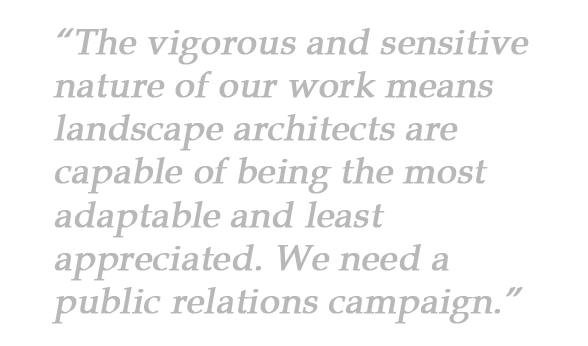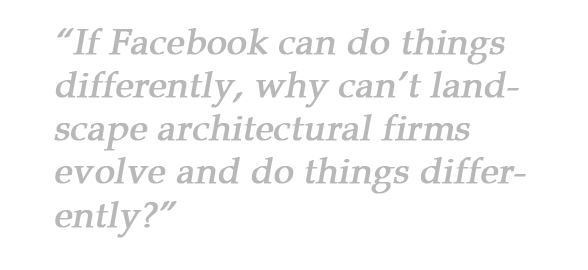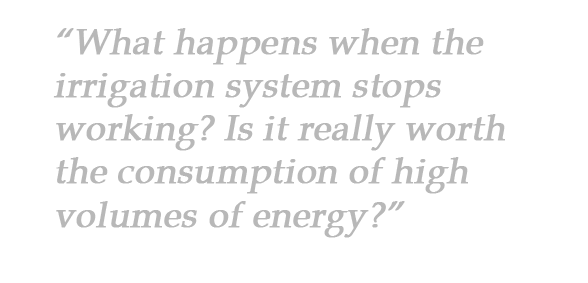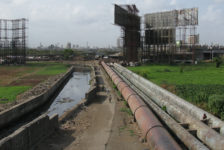Article by Win Phyo – In this article, we take a closer look at landscape architecture today and investigate just what is wrong with this profession. In current times, we cannot deny that landscape architecture is indeed a growing profession. In 2011, the National Endowment for the Arts, NEC, predicted future job prospects for several artistic occupations through to 2018 within the U.S. and landscape architecture came out with one of the highest projected growth rates of 20%. Since 1863, when Fredrick Law Olmsted adopted the title “landscape architect,” the profession has digressed into several areas of expertise from landscape planning, to management, to design, which can be further divided into areas of conservation, science, the arts, and many other applications. So much so that landscape architects have coined themselves as “Stewards of the Land”. The accumulated development of the profession has also made landscape architecture vulnerable, for example, to the influence of popular trends and culture. It has never been a better time to now pause, take a step back, and look at the profession with a critical eye.
Landscape Architecture Today
10. Our Professional Organizations are not Doing Enough to Promote the Profession
It is time to get over the fact that landscape architecture is a relatively new or young profession. It has been about 150 years since the profession has been recognized (if you recall the mid-nineteenth century establishment of its identity).  There are now so many professional organizations that represent landscape architects nationally and worldwide, from ASLA in the U.S, LI in the U.K., AILA in Australia to IFLA Europe and IFLA World. Yet I still find myself explaining that we do not just do garden design. Sustainable and resilient modes of thinking demand that landscape architects lead the way but as landscape “stewards,” are we having much of an impact? Frankly, I am concerned that our respective professional organizations are not doing an effective job at getting the word out about who we are and what we do. The vigorous and sensitive nature of our work means landscape architects are capable of being the most adaptable and least appreciated. We need a public relations campaign.
There are now so many professional organizations that represent landscape architects nationally and worldwide, from ASLA in the U.S, LI in the U.K., AILA in Australia to IFLA Europe and IFLA World. Yet I still find myself explaining that we do not just do garden design. Sustainable and resilient modes of thinking demand that landscape architects lead the way but as landscape “stewards,” are we having much of an impact? Frankly, I am concerned that our respective professional organizations are not doing an effective job at getting the word out about who we are and what we do. The vigorous and sensitive nature of our work means landscape architects are capable of being the most adaptable and least appreciated. We need a public relations campaign.
9. Landscape Architects Fail to Pursue Bigger Decision-making Roles
There may be a general inferiority complex within the profession. As Mark Hough has rightly stated in his article, landscape architects “have had a tougher time finding seats at the table alongside planners and architects when broader planning decisions are being made.” ASLA has also questioned this statement back in 2012. Landscape architects need to assert themselves as designers of all public infrastructures. Working as a planner is a decision-making position but land uses can be better regulated and revived using the spatial design knowledge and skills we fundamentally possess.
8. Students are not Taught to Understand the Real Practice of the Profession
Last July, I finished four years of design education where I emerged with a B.A. and M.A. in Landscape Architecture. Yet with my diploma in hand, I am still pondering about what it means to practice as a landscape architect. Design school is all about selling your idea, no matter how bad it would be in reality.  Why do students in design school create marketable but unrealistic proposals when our job is to design places that ought to be built one day? Design studio culture shuts students inside and away from intermingling with people unlike themselves. If we spent time, from much earlier stages, delving into interpreting ecological or social patterns and learned to place importance on feasibility and actual implementation of a project, we would be much better equipped to grapple the ropes of good practice.
Why do students in design school create marketable but unrealistic proposals when our job is to design places that ought to be built one day? Design studio culture shuts students inside and away from intermingling with people unlike themselves. If we spent time, from much earlier stages, delving into interpreting ecological or social patterns and learned to place importance on feasibility and actual implementation of a project, we would be much better equipped to grapple the ropes of good practice.
7. Office Culture Needs to Start Reflecting the Work we do
Historically, from the likes of the French landscape architect André Le Nôtre, who designed the park of the Palace of Versailles, our industry has been about the aesthetics of projects. It then evolved to include showing sensitivity to environments and is now touching on resiliency and the effects of personal well-being. We are, at times, building projects for the wrong reasons; focused on “building” landscapes rather than building up people and relationships. Office culture can certainly do better to start this discussion.  Facebook, the social media giant, is leading discussions of the digital world and they have a unique office culture to match what they are preaching. If Facebook can do things differently, why can’t landscape architectural firms evolve and do things differently? After all, our mindsets influence our designs, which in turn translates to our projects and are reflected on the product users.
Facebook, the social media giant, is leading discussions of the digital world and they have a unique office culture to match what they are preaching. If Facebook can do things differently, why can’t landscape architectural firms evolve and do things differently? After all, our mindsets influence our designs, which in turn translates to our projects and are reflected on the product users.
6. Young Professionals Lack the Necessary Horticultural Knowledge
What clearly differentiates landscape architects from fellow professionals in artistic occupations is our ability to specify planting species for different purposes . However, young professionals today often have little background knowledge on plants. The school system should also be encouraging horticultural studies as a strong basis of the learning component if one wants to practice as a landscape architect. The implications of specifying wrong species can have a huge impact in the built environment. An example is to know the right species of trees to specify in urban landscapes. James Urban, an American landscape architect, has even written the ASLA award-winning book “Up by Roots” to help the professionals specify the right trees in the built environment.
5. The Profession Needs to Stress the Importance of Maintenance
The value of maintenance is vital in the profession since we only see the fruits of our work over a long period of time and what happens during this time, after the ground works have been completed, will determine the success of the project.  Of course, it all comes down to cost in the end; however, time constraints and lack of manpower in maintaining completed sites can ruin the initial hard work. Some maintenance contractors can often fail to recognize their role and landscape architects don’t always have the scope to help with the longevity of the project. All in all, large sites with big budgets may do fine but it is the everyday public spaces which need the most attention.
Of course, it all comes down to cost in the end; however, time constraints and lack of manpower in maintaining completed sites can ruin the initial hard work. Some maintenance contractors can often fail to recognize their role and landscape architects don’t always have the scope to help with the longevity of the project. All in all, large sites with big budgets may do fine but it is the everyday public spaces which need the most attention.
4. There is Robotic Geometry Overload Within the Profession
Landscape architects will need to overcome the need for perfection; countless designs today have more focus on creating the perfect geometry than on spending quality time studying the big picture. Place-making and the creation of ecologically healthy spaces requires much more from the profession than geometry being a driver for design.  Books such as “From Concept to Form in Landscape Design” do not help with the issue where designed spaces can become completely unfit for their surroundings. Isn’t it time we accepted that there can be no given systematic approach and that creating the perfect curve in AutoCAD is incomparable to the real issues we ought to deal with?
Books such as “From Concept to Form in Landscape Design” do not help with the issue where designed spaces can become completely unfit for their surroundings. Isn’t it time we accepted that there can be no given systematic approach and that creating the perfect curve in AutoCAD is incomparable to the real issues we ought to deal with?
3. We Fall into the Trap of Valuing Flashy Innovation for its Own Sake
Another idea landscape architecture students have become prey to, like their professional counterparts, is that innovation for its own sake is a good thing. Take green walls for example; from the likes of Patrick Blanc’s work, where corporate clients use them in both the literal and figurative sense to project a rich and green image.  What happens when the irrigation system stops working? Is it really worth the consumption of high volumes of energy? Designing spaces based on flashy innovation means they are vulnerable, like fashion trends, to become outdated and to lack any real substance. Flashy lighting is another example in which the space becomes merely a tool for a lighting show. No doubt, the public loves the design flair, but the innovative beauty must be complimented by robust depth, function and intention for when the innovation becomes redundant.
What happens when the irrigation system stops working? Is it really worth the consumption of high volumes of energy? Designing spaces based on flashy innovation means they are vulnerable, like fashion trends, to become outdated and to lack any real substance. Flashy lighting is another example in which the space becomes merely a tool for a lighting show. No doubt, the public loves the design flair, but the innovative beauty must be complimented by robust depth, function and intention for when the innovation becomes redundant.
2. The Profession has the Wrong Idea of a “Concept”
A large part of the profession is concerned with storytelling. The problem is that then our idea of the concept also falls prey to abstraction. What is your concept? This is the question that all students and professionals ask themselves and each other, yet our idea of the concept in landscape design is lacking clarification. Concept may very well be seen as the artistic component of design but concept-driven process should be analyzed and the profession must work in more relational and flexible ways. We have to consider the ecological, geological, political, social and cultural processes and forces, which indeed can be the make-up of what we view currently to be a single “concept”.
1. There is not Enough Post-Occupancy Evaluation (POE)
Post-occupancy evaluation still remains elusive within the profession; its importance is often undermined as part of the design practice. The Landscape Architecture Foundation’s (LAF) Case Study Information (CSI) program is one of the few examples that seek to investigate landscape performance. As ASLA points out , the value of such qualitative and quantitative research with robust data helps in communicating the importance of the profession to those without landscape design expertise. Yet the problem lies in the lack of research and participants. As we find out the user satisfaction with our most impactful projects like the New York’s High Line, we can better prepare our cities for the next century. Hence, POE needs to be better integrated into the profession, especially once a project has been completed. – The 10 things we have mentioned above are not only food for thought but also food for action. By making ourselves aware of the current nature of our profession, we all have a responsibility to remedy the cracks in the system. In most cases, it is not the case of conscious acts of bad practice but of not being conscious enough. Artistic occupations are most often exposed to the subjective eyes of the public and we must not only acknowledge this aspect but also look ahead and become Stewards of the Profession that is constantly dynamic and interpenetrating. You now know our Top Ten, we would love to hear your views and points. What are the things that are wrong with landscape architecture today, based from your own experiences?
Recommended Reading:
- Becoming an Urban Planner: A Guide to Careers in Planning and Urban Design by Michael Bayer
- Sustainable Urbanism: Urban Design With Nature by Douglas Farrs
- eBooks by Landscape Architects Network
Featured image credit: Alexander Pidgeon, via Unsplash
Published in Blog










Pingback: Episode 005: Landscape Architecture and it’s problems – Talking about Landscape Architecture